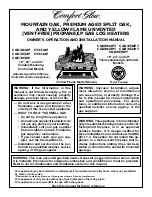
2.2 Ventilation
Requirements
WARNING
Insufficient ventilation may result in health problems, carbon
monoxide poisoning, or death. Always vent enclosed spaces
and buildings according to national, state, provincial, and
local codes.
These heaters are the unvented type. Products of combustion generated are released
into the space being heated. Sufficient ventilation of fresh air is required to provide
adequate air for efficient combustion and to dilute and remove the products of combus-
tion.
In the United States
, the minimum intake and exhaust air openings shall provide for
not less than 4 CFM per 1,000 BTUH (0.38m3 a minute per kW). In the United States,
this may be accomplished by either gravity or mechanical means. Both exhaust fans
and inlet air openings are required in tight buildings. Exhaust openings for removing
flue products shall be above the level of the heater (ANSI Z223.1/NFPA 54, section
10.18, Infrared Heaters).
Air for combustion, ventilation, and dilution of flue gases shall be obtained by applica-
tion of one of several methods described in the National Fuel Gas Code, ANSI Z223.1/
NFPA 54, section 9.3, Air for Combustion and Ventilation.
The ventilation technical information outlined in the current ASHRAE Handbooks
should be observed when locating vents. When mechanical means are provided to
supply and exhaust, a positive interlock with the heater thermostat must be provided by
the installer so that the heater cannot operate unless the supply and exhaust system
is operating.
Mechanical exhaust fans are typically located at high points of the building. For flat
roof areas, a series of small exhausters should be distributed over the roof areas and
interlocked with various heating zones. Local codes may permit the use of humidistat
control to remove water vapor and products of combustion. Humidistat settings will
typically be in the 40 to 55% relative humidity range.
Fresh air intake openings are typically located high on the building sidewalls at or
above the level of the heaters. One square inch of net free inlet area per 1,000
BTUH
(22cm
2
per kW) is required.
Multiple inlets, well distributed, should be used and should
direct air upward to prevent drafts at floor level. Inlets are typically limited to 1 to 2
square feet (900-1800cm
2
) in size.
Total area required can be computed by divid-
ing exhaust CFM by 500 feet per minute. (Total area required can be computed
by dividing exhaust cubic meters per minute by 152 meters per minute.)
In Canada
, the Natural Gas and Propane Installation Code CAN/CSA B149.1 (latest
edition) requires the use of mechanical ventilation. The heater shall be provided with
mechanical ventilation for combustion and ventilation air:
(1)
that is so located that products of combustion from each heater are
effectively removed outdoors;
(2)
that has a ventilation volume of at least 3 CFM per 1,000 BTUH (0.29m3
a minute per kW) for natural gas and 4 CFM per 1,000 BTUH (0.38m3 a
minute per kW) for LP/propane; and
(3)
is sufficient to maintain the level of carbon dioxide at less than 5000 ppm
measured 6 ft (2M) above the work area.
3.0 Receiving
Check for any damage that may have been incurred during shipment.
If damage is found, document the damage with the transporting agency and immedi-
ately contact your distributor. If you are an authorized Distributor, follow the FOB freight
policy procedures provided by Thomas & Betts for this product.
Form I-RIH, P/N 131793R8, Page 5






































